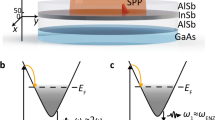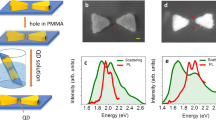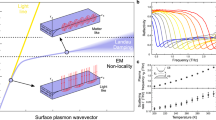Abstract
Cavity–emitter coupling can enable a host of potential applications in quantum optics, from low-threshold lasers to brighter single-photon sources for quantum cryptography1. Although some of the first demonstrations of spontaneous emission modification occurred in metallic structures2,3, it was only after the recent demonstration of cavity quantum electrodynamics effects in dielectric optical cavities4 that metal-based optical cavities were considered for quantum optics applications5,6,7,8,9,10,11,12,13. Advantages of metal–optical cavities include their compatibility with a large variety of emitters and their broadband cavity spectra, which enable enhancement of spectrally broad emitters. Here, we demonstrate radiative emission rate enhancements approaching 1,000 for emitters coupled to the nanoscale gap between a silver nanowire and a silver substrate. A quantitative comparison of our results with analytical theory shows that the enhanced emission rate of gap-mode plasmons in our structures can yield high internal quantum efficiency despite the close proximity of metal surfaces.
This is a preview of subscription content, access via your institution
Access options
Subscribe to this journal
Receive 12 print issues and online access
$209.00 per year
only $17.42 per issue
Buy this article
- Purchase on Springer Link
- Instant access to full article PDF
Prices may be subject to local taxes which are calculated during checkout




Similar content being viewed by others
References
Noda, S., Fujita, M. & Asano, T. Spontaneous-emission control by photonic crystals and nanocavities. Nature Photon. 1, 449–458 (2007).
Chance, R. R., Prock, A. & Silbey, R. Molecular fluorescence and energy transfer near interfaces. Adv. Chem. Phys. 37, 1–65 (1978).
Moskovits, M. Surface-enhanced spectroscopy. Rev. Mod. Phys. 57, 783–826 (1985).
Shields, A. J. Semiconductor quantum light sources. Nature Photon. 1, 215–223 (2007).
Chang, D. E., Sorensen, A. S., Hemmer, P. R. & Lukin, M. D. Quantum optics with surface plasmons. Phys. Rev. Lett. 97, 053002 (2006).
Maier, S. Effective mode volume of nanoscale plasmon cavities. Opt. Quant. Electron. 38, 257–267 (2006).
Gong, Y. & Vučković, J. Design of plasmon cavities for solid-state cavity quantum electrodynamics applications. Appl. Phys. Lett. 90, 033113 (2007).
Jun, Y. C., Kekatpure, R. D., White, J. S. & Brongersma, M. L. Nonresonant enhancement of spontaneous emission in metal–dielectric–metal plasmon waveguide structures. Phys. Rev. B 78, 153111 (2008).
Esteban, R., Teperik, T. V. & Greffet, J. J. Optical patch antennas for single photon emission using surface plasmon resonances. Phys. Rev. Lett. 104, 026802 (2010).
Vesseur, E. J. R., de Abajo, F. J. G. & Polman, A. Broadband Purcell enhancement in plasmonic ring cavities. Phys. Rev. B 82, 165419 (2010).
Miyazaki, H. T. & Kurokawa, Y. Squeezing visible light waves into a 3-nm-thick and 55-nm-long plasmon cavity. Phys. Rev. Lett. 96, 097401 (2006).
Gong, Y., Lu, J., Cheng, S.-L., Nishi, Y. & Vučković, J. Plasmonic enhancement of emission from Si-nanocrystals. Appl. Phys. Lett. 94, 013106 (2009).
Jun, Y. C., Pala, R. & Brongersma, M. L. Strong modification of quantum dot spontaneous emission via gap plasmon coupling in metal nanoslits. J. Phys. Chem. C 114, 7269–7273 (2010).
Brongersma, M. L. & Shalaev, V. M. The case for plasmonics. Science 328, 440–441 (2010).
Schuller, J. A. et al. Plasmonics for extreme light concentration and manipulation. Nature Mater. 9, 193–204 (2010).
Gramotnev, D. K. & Bozhevolnyi, S. I. Plasmonics beyond the diffraction limit. Nature Photon. 4, 83–91 (2010).
Hennessy, K. et al. Quantum nature of a strongly coupled single quantum dot–cavity system. Nature 445, 896–899 (2007).
Yoon, I. et al. Single nanowire on a film as an efficient SERS-active platform. J. Am. Chem. Soc. 131, 758–762 (2009).
Russell, K. J. & Hu, E. L. Gap-mode plasmonic nanocavity. Appl. Phys. Lett. 97, 163115 (2010).
McMahon, J. M., Gray, S. K. & Schatz, G. C. Nonlocal optical response of metal nanostructures with arbitrary shape. Phys. Rev. Lett. 103, 097403 (2009).
Nagpal, P., Lindquist, N. C., Oh, S.-H. & Norris, D. J. Ultrasmooth patterned metals for plasmonics and metamaterials. Science 325, 594–597 (2009).
Priestley, R., Sokolik, I., Walser, A. D., Tang, C. W. & Dorsinville, R. Photooxidation effects on picosecond photoluminescence and photoconductivity in tris-(8-hydroxyquinoline) aluminum (Alq3). Synth. Met. 84, 915–916 (1997).
Acknowledgements
The authors acknowledge support from the NSF/NSEC (NSF/PHY-06-46094), the use of NSF/NNIN facilities at Harvard University's Center for Nanoscale Systems, and the use of the HPC computer cluster at Harvard.
Author information
Authors and Affiliations
Contributions
K.J.R. designed and performed experiments, analysed data and wrote the paper. T.L.L. designed and performed experiments and analysed data. S.Y.C. performed experiments. E.L.H. designed experiments, analysed data and wrote the paper.
Corresponding author
Ethics declarations
Competing interests
The authors declare no competing financial interests.
Supplementary information
Supplementary information
Supplementary information (PDF 1094 kb)
Rights and permissions
About this article
Cite this article
Russell, K., Liu, TL., Cui, S. et al. Large spontaneous emission enhancement in plasmonic nanocavities. Nature Photon 6, 459–462 (2012). https://doi.org/10.1038/nphoton.2012.112
Received:
Accepted:
Published:
Issue Date:
DOI: https://doi.org/10.1038/nphoton.2012.112
This article is cited by
-
Dynamical control of nanoscale light-matter interactions in low-dimensional quantum materials
Light: Science & Applications (2024)
-
Bullseye dielectric cavities for photon collection from a surface-mounted quantum-light-emitter
Scientific Reports (2023)
-
Gigantic suppression of recombination rate in 3D lead-halide perovskites for enhanced photodetector performance
Nature Photonics (2023)
-
Large Plasmonic Resonance Shifts from Metal Loss in Slits
Plasmonics (2022)
-
Spontaneous emission in micro- or nanophotonic structures
PhotoniX (2021)



